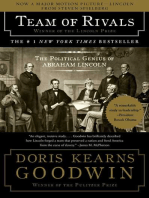Constant Velocity Worksheet 1 - Display
Constant Velocity Worksheet 1 - Display
Uploaded by
Robert CampilloCopyright:
Available Formats
Constant Velocity Worksheet 1 - Display
Constant Velocity Worksheet 1 - Display
Uploaded by
Robert CampilloOriginal Title
Copyright
Available Formats
Share this document
Did you find this document useful?
Is this content inappropriate?
Copyright:
Available Formats
Constant Velocity Worksheet 1 - Display
Constant Velocity Worksheet 1 - Display
Uploaded by
Robert CampilloCopyright:
Available Formats
UNIT II Worksheet 1
1. Consider the position vs. time graph below for cyclists A and B.
a. Do the cyclists start at the same point? How do you know? If not, which is ahead?
No. According to the graph you can see that the position of B is higher than the
position of rider A. Therefore, rider B is ahead rider A when they start.
b. At t= 7s, which cyclist is ahead? How do you know?
©Modeling Workshop Project 2006 1 Unit II ws1 v3.1
Since t= 7s is to the right of t= 5s. We can use this information to say that A is
higher at t= 7s
c. Which cyclist is travelling faster at t = 3s? How do you know?
Rider A has a greater slope therefore rider A is faster than rider B. We know
that speed is equal to the slope of the line.
©Modeling Workshop Project 2006 2 Unit II ws1 v3.1
d. Are their velocities equal at any time? How do you know?
No, the lines that are shown are straight. We know that straight lines have a slope
that is constant. Knowing this we know that the slope for rider A is greater
than the slope of rider B. Because of this we know that A is traveling faster, and
they will never go at equal speeds at any time.
e. What is happening at the intersection of lines A and B?
At the intersection of lines, A and B, is where they will be at the same place at the
same time.
©Modeling Workshop Project 2006 3 Unit II ws1 v3.1
2. Consider the new position vs. time graph below for cyclists A and B.
a. How does the motion of the cyclist A in the new graph compare to that of A in the
previous graph from page one?
In the new graph cyclist, A is traveling in a different direction.
b. How does the motion of cyclist B in the new graph compare to that of B in the
previous graph?
The motion of cyclist B doesn’t change in the new graph.
©Modeling Workshop Project 2006 4 Unit II ws1 v3.1
c. Which cyclist has the greater speed? How do you know?
Cyclist A has more speed because we know the slope for A is greater than the
graph for cyclist B. Since A is the same in both graphs just go in different
directions we can conclude this.
d. Describe what is happening at the intersection of lines A and B.
The intersections of lines A and B shows that rider A and Rider B will be at that
point at the same time.
©Modeling Workshop Project 2006 5 Unit II ws1 v3.1
e. Which cyclist traveled a greater distance during the first 5 seconds? How do you
know?
Cyclist A traveled more during the first 5 seconds. We know this because the
change of rider A is greater than the change of rider B in the positions during
the first 5 seconds.
©Modeling Workshop Project 2006 6 Unit II ws1 v3.1
You might also like
- The Subtle Art of Not Giving a F*ck: A Counterintuitive Approach to Living a Good LifeFrom EverandThe Subtle Art of Not Giving a F*ck: A Counterintuitive Approach to Living a Good LifeRating: 4 out of 5 stars4/5 (5940)
- The Gifts of Imperfection: Let Go of Who You Think You're Supposed to Be and Embrace Who You AreFrom EverandThe Gifts of Imperfection: Let Go of Who You Think You're Supposed to Be and Embrace Who You AreRating: 4 out of 5 stars4/5 (1108)
- Never Split the Difference: Negotiating As If Your Life Depended On ItFrom EverandNever Split the Difference: Negotiating As If Your Life Depended On ItRating: 4.5 out of 5 stars4.5/5 (886)
- Grit: The Power of Passion and PerseveranceFrom EverandGrit: The Power of Passion and PerseveranceRating: 4 out of 5 stars4/5 (598)
- Hidden Figures: The American Dream and the Untold Story of the Black Women Mathematicians Who Helped Win the Space RaceFrom EverandHidden Figures: The American Dream and the Untold Story of the Black Women Mathematicians Who Helped Win the Space RaceRating: 4 out of 5 stars4/5 (925)
- Shoe Dog: A Memoir by the Creator of NikeFrom EverandShoe Dog: A Memoir by the Creator of NikeRating: 4.5 out of 5 stars4.5/5 (545)
- The Hard Thing About Hard Things: Building a Business When There Are No Easy AnswersFrom EverandThe Hard Thing About Hard Things: Building a Business When There Are No Easy AnswersRating: 4.5 out of 5 stars4.5/5 (354)
- Elon Musk: Tesla, SpaceX, and the Quest for a Fantastic FutureFrom EverandElon Musk: Tesla, SpaceX, and the Quest for a Fantastic FutureRating: 4.5 out of 5 stars4.5/5 (476)
- Her Body and Other Parties: StoriesFrom EverandHer Body and Other Parties: StoriesRating: 4 out of 5 stars4/5 (831)
- The Emperor of All Maladies: A Biography of CancerFrom EverandThe Emperor of All Maladies: A Biography of CancerRating: 4.5 out of 5 stars4.5/5 (274)
- The World Is Flat 3.0: A Brief History of the Twenty-first CenturyFrom EverandThe World Is Flat 3.0: A Brief History of the Twenty-first CenturyRating: 3.5 out of 5 stars3.5/5 (2272)
- The Yellow House: A Memoir (2019 National Book Award Winner)From EverandThe Yellow House: A Memoir (2019 National Book Award Winner)Rating: 4 out of 5 stars4/5 (99)
- The Little Book of Hygge: Danish Secrets to Happy LivingFrom EverandThe Little Book of Hygge: Danish Secrets to Happy LivingRating: 3.5 out of 5 stars3.5/5 (419)
- Devil in the Grove: Thurgood Marshall, the Groveland Boys, and the Dawn of a New AmericaFrom EverandDevil in the Grove: Thurgood Marshall, the Groveland Boys, and the Dawn of a New AmericaRating: 4.5 out of 5 stars4.5/5 (270)
- The Sympathizer: A Novel (Pulitzer Prize for Fiction)From EverandThe Sympathizer: A Novel (Pulitzer Prize for Fiction)Rating: 4.5 out of 5 stars4.5/5 (122)
- Team of Rivals: The Political Genius of Abraham LincolnFrom EverandTeam of Rivals: The Political Genius of Abraham LincolnRating: 4.5 out of 5 stars4.5/5 (235)
- A Heartbreaking Work Of Staggering Genius: A Memoir Based on a True StoryFrom EverandA Heartbreaking Work Of Staggering Genius: A Memoir Based on a True StoryRating: 3.5 out of 5 stars3.5/5 (232)
- On Fire: The (Burning) Case for a Green New DealFrom EverandOn Fire: The (Burning) Case for a Green New DealRating: 4 out of 5 stars4/5 (75)
- The Unwinding: An Inner History of the New AmericaFrom EverandThe Unwinding: An Inner History of the New AmericaRating: 4 out of 5 stars4/5 (45)
- Approximation To The Hydrodynamics of Oating Pontoons Under Oblique WavesDocument20 pagesApproximation To The Hydrodynamics of Oating Pontoons Under Oblique WavesÖmer SukasNo ratings yet
- Chemistry Lab ReportDocument6 pagesChemistry Lab ReportTowhid KhanNo ratings yet
- FD GGF PDFDocument739 pagesFD GGF PDFRaminRashidiNo ratings yet
- Fluent 6.3: Population Balance Module ManualDocument55 pagesFluent 6.3: Population Balance Module ManualHarshit KapadiaNo ratings yet
- Potentiometer 12th CBSE PhysicsDocument26 pagesPotentiometer 12th CBSE PhysicsShivansh DubeyNo ratings yet
- Dr. Ranojit Kumar Dutta (DRD)Document27 pagesDr. Ranojit Kumar Dutta (DRD)KRZ. Arpon Root HackerNo ratings yet
- Physics Laboratory Report On Simple PendulumDocument9 pagesPhysics Laboratory Report On Simple PendulumTesfamichael AbathunNo ratings yet
- Hsslive-xi-physics-Ayyappan-chapter 7 - Systems of Particles - Rotational Motion (Repaired)Document10 pagesHsslive-xi-physics-Ayyappan-chapter 7 - Systems of Particles - Rotational Motion (Repaired)Harish SridharNo ratings yet
- Pre GATE2018 Chemical Engineering Test 3Document22 pagesPre GATE2018 Chemical Engineering Test 3PANKAJ AGRAHARINo ratings yet
- Class 12 - Physics - AtomsDocument17 pagesClass 12 - Physics - AtomsSOUMYA SHOUVIKNo ratings yet
- Design and Fabrication of Perpetual Motion Hydroelectric Power Generator - IRJASHDocument9 pagesDesign and Fabrication of Perpetual Motion Hydroelectric Power Generator - IRJASHIRJASH100% (1)
- What Are Electromagnetic Waves?Document67 pagesWhat Are Electromagnetic Waves?nhixoleNo ratings yet
- 3 - Capacitance of Transmission LineDocument23 pages3 - Capacitance of Transmission Linekhaled mahmudNo ratings yet
- Download ebooks file (eBook PDF) Electromagnetics 2nd Edition by Arlon T Adams all chaptersDocument49 pagesDownload ebooks file (eBook PDF) Electromagnetics 2nd Edition by Arlon T Adams all chaptersmacharmellal100% (2)
- A Validated CFD Model of Plain and Serrated Fin-Tube BundlesDocument10 pagesA Validated CFD Model of Plain and Serrated Fin-Tube BundlesHitesh BachhavNo ratings yet
- Rayleigh-Bénard Convection For Different: Numerical ImplementationDocument13 pagesRayleigh-Bénard Convection For Different: Numerical ImplementationRishabh JaiswalNo ratings yet
- 3 - Energy, Energy Transfer, Energy AnalysisDocument22 pages3 - Energy, Energy Transfer, Energy Analysisrashedramadan46No ratings yet
- Docc 1988Document5 pagesDocc 1988swchen100% (2)
- Practicum Report " Practicum Name"Document2 pagesPracticum Report " Practicum Name"MOHAMMED AMEEN MOHAMMED QAIDNo ratings yet
- Lt3 TranspoDocument24 pagesLt3 TranspoRachelle PedronNo ratings yet
- Dimensional AnalysisDocument2 pagesDimensional AnalysisKenneth MaimaNo ratings yet
- Chapter 2 EemDocument5 pagesChapter 2 EemTanishq MudaliarNo ratings yet
- COSMOS: Complete Online Solutions Manual Organization SystemDocument7 pagesCOSMOS: Complete Online Solutions Manual Organization Systemcurrjek0% (2)
- Waves Crossing Boundaries Homework 1: Name Class DateDocument1 pageWaves Crossing Boundaries Homework 1: Name Class Datedrz0mNo ratings yet
- TSF in SRMDocument10 pagesTSF in SRMakhilnandanNo ratings yet
- WSM PDFDocument17 pagesWSM PDFSathish SelvaNo ratings yet
- Load CellsDocument24 pagesLoad CellsKevinAngeloMaNo ratings yet
- Class-4 - Flat Plate 2 - WSDDocument10 pagesClass-4 - Flat Plate 2 - WSDRifat HasanNo ratings yet
- Motion in A Straight Line Subjective QuestionsDocument58 pagesMotion in A Straight Line Subjective QuestionsUnkown BuddyNo ratings yet
- Chapter 3 2D Part CompleteDocument31 pagesChapter 3 2D Part CompleteTest PierceNo ratings yet






































































